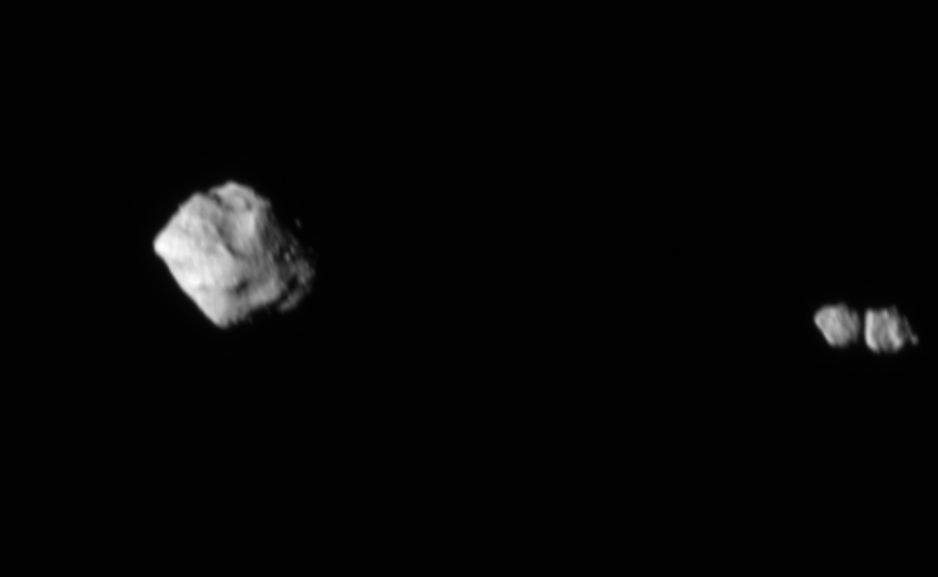There are millions of asteroids floating around the solar system. With so many of them, it should be no surprise that some are weirdly configured. A recent example of one of these weird configurations was discovered when Lucy, NASA’s mission to the Trojan asteroids, passed by a main-belt asteroid called Dinkinesh. It found that Dinkinesh had a “moon” – and that moon was a “contact binary”. Now known as Selam, it is made up of two objects that physically touch one another through gravity but aren’t fully merged into one another. Just how and when such an unexpected system might have formed is the subject of a new paper by Colby Merrill, a graduate researcher at Cornell, and their co-authors at the University of Colorado and the University of Bern.
Continue reading “Finding The Age Of A Contact Binary “Moon””What Are Multiple Star Systems?
When we do finally learn the full truth about our place in the galaxy, and we’re invited to join the Galactic Federation of Planets, I’m sure we’ll always be seen as a quaint backwater world orbiting a boring single star.
The terrifying tentacle monsters from the nightmare tentacle world will gurgle horrifying, but clearly condescending comments about how we’ve only got a single star in the Solar System.
The beings of pure energy will remark how only truly enlightened civilizations can come from systems with at least 6 stars, insulting not only humanity, but also the horrifying tentacle monsters, leading to another galaxy spanning conflict.
Yes, we’ll always be making up for our stellar deficit in the eyes of aliens, or whatever those creepy blobs use for eyes.
What we lack in sophistication, however, we make up in volume. In our Milky Way, fully 2/3rds of star systems only have a single star. The last 1/3rd is made up of multiple star systems.
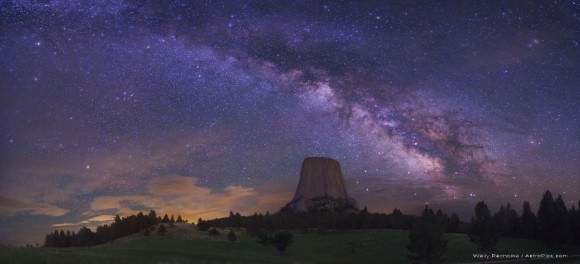
We’re taking binary stars, triple star systems, even exotic 7 star systems. When you mix and match different types of stars in various Odd Couple stellar apartments, the results get interesting.
Consider our own Solar System, where the Sun and planets formed together out a cloud of gas and dust. Gravity collected material into the center of the Solar System, becoming the Sun, while the rest of the disk spun up faster and faster. Eventually our star ignited its fusion furnace, blasting out the rest of the stellar nebula.
But different stellar nebulae can lead to the formation of multiple stars instead. What you get depends on the mass of the cloud, and how fast it’s rotating.
Check out this amazing photograph of a multiple star system forming right now.
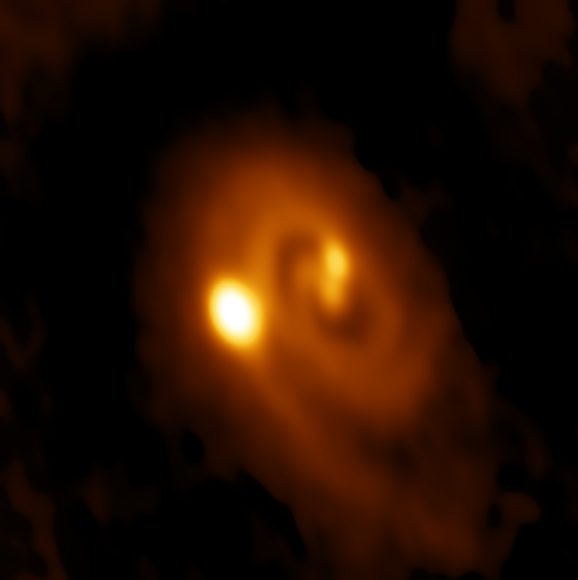
In this image, you can see three stars forming together, two at the center, about 60 astronomical units away from each other (60 times the distance from the Earth to the Sun), and then a third orbiting 183 AU away.
It’s estimated these stars are only 10,000 to 20,000 years old. This is one of the most amazing astronomy pictures I ever seen.
When you have two stars, that’s a binary system. If the stars are similar in mass to each other, then they orbit a common point of mass, known as the barycenter. If the stars are different masses, then it can appear that one star is orbiting the other, like a planet going around a star.
When you look up in the sky, many of the single stars you see are actually binary stars, and can be resolved with a pair of binoculars or a small telescope. For example, in a good telescope, Alpha Centauri can be resolved into two equally bright stars, with the much dimmer Proxima Centauri hanging out nearby.
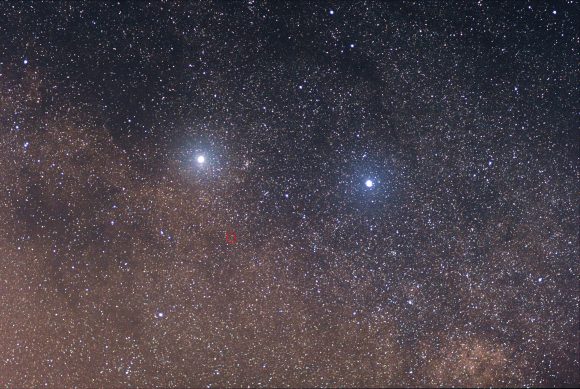
You have to be careful, though, sometimes stars just happen to be beside each other in the sky, but they’re not actually orbiting one another – this is known as an optical binary. It’s a trap.
Astronomers find that you can then get binary stars with a third companion orbiting around them. As long as the third star is far enough away, the whole system can be stable. This is a triple star system.
You can get two sets of binary stars orbiting each other, for a quadruple star system.
In fact, you can build up these combinations of stars up. For example, the star system Nu Scorpii has 7 stars in a single system. All happily orbiting one another for eons.
If stars remained unchanging forever, then this would be the end of our story. However, as we’ve discussed in other articles, stars change over time, bloating up as red giants, detonating as supernovae and turning into bizarre objects, like white dwarfs, neutron stars and even black holes. And when these occur in multiple star systems, well, watch the sparks fly.
There are a nearly infinite combinations you can have here: main sequence, red giant, white dwarf, neutron star, and even black holes. I don’t have time to go through all the combinations, but here are some highlights.
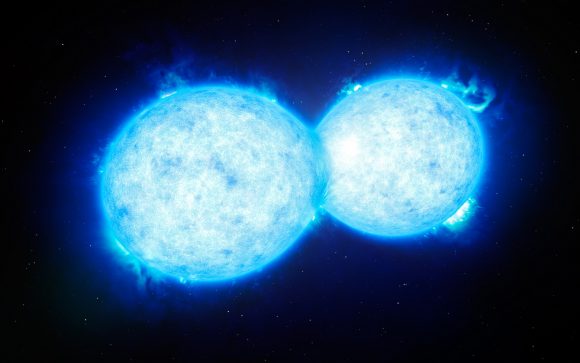
For starters, binary stars can get so close they actually touch each other. This is known as a contact binary, where the two stars actually share material back and forth. But it gets even stranger.
When a main sequence star like our Sun runs out of hydrogen fuel in its core, it expands as a red giant, before cooling and becoming a white dwarf.
When a red giant is in a binary system, the distance and evolution of its stellar companion makes all the difference.
If the two stars are close enough, the red giant can pass material over to the other star. And if the red giant is large enough, it can actually engulf its companion. Imagine our Sun, orbiting within the atmosphere of a red giant star. Needless to say, that’s not healthy for any planets.
An even stranger contact binary happens when a red giant consumes a binary neutron star. This is known as a Thorne-Zytkow object. The neutron star spirals inward through the atmosphere of the red giant. When it reaches the core, it either becomes a black hole, gobbling up the red giant from within, or an even more massive neutron star. This is exceedingly rare, and only one candidate object has ever been observed.
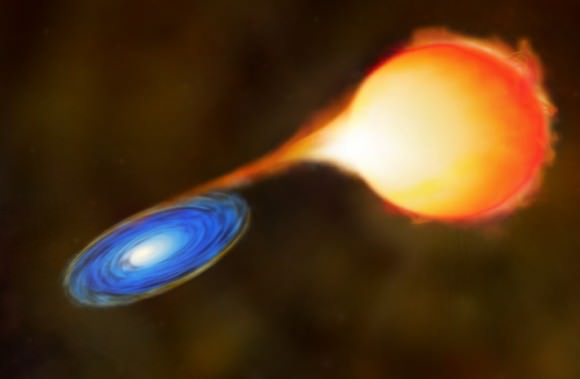
When a binary pair is a white dwarf, the dead remnant of a star like our Sun, then material can transfer to the surface of the white dwarf, causing novae explosions. And if enough material is transferred, the white dwarf explodes as a Type 1A supernova.
If you’re a star that was unlucky enough to be born beside a very massive star, you can actually kicked off into space when it explodes as a supernova. In fact, there are rogue stars which such a kick, they’re on an escape trajectory from the entire galaxy, never to return.
If you have two neutron stars in a binary pair, they release energy in the form of gravitational waves, which causes them to lose momentum and spiral inward. Eventually they collide, becoming a black hole, and detonating with so much energy we can see the explosions billions of light-years away – a short-period gamma ray burst.
The combinations are endless.
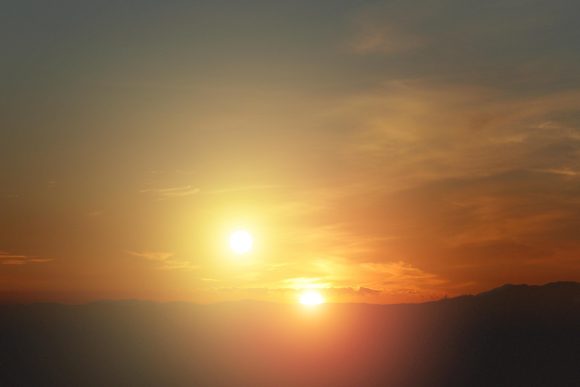
It’s amazing to think what the night sky would look like if we were born into a multiple star system. Sometimes there would be several stars in the sky, other times just one. And rarely, there would be an actual night.
How would life be different in a multiple star system? Let me know your thoughts in the comments.
In our next episode, we try to untangle this bizarre paradox. If the Universe is infinite, how did it start out as a singularity? That doesn’t make any sense.
We glossed over it in this episode, but one of the most interesting effects of multiple star systems are novae, explosions of stolen material on the surface of a white dwarf star. Learn more about it in this video.
Rosetta Zooms Toward an Extraordinary Comet
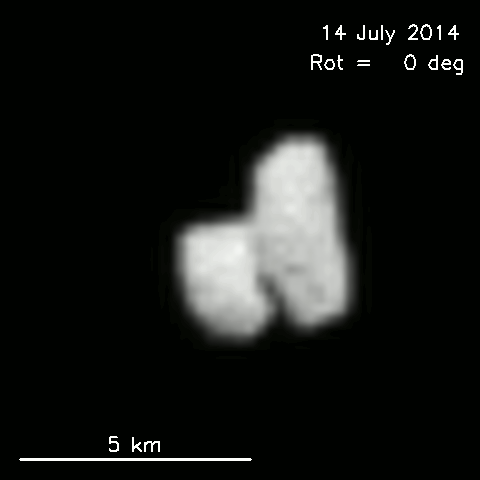
I thought the photos earlier this week were amazing. This little movie, made of 36 ‘smoothed’ or interpolated images of Comet 67P/Churyumov-Gerasimenko, takes it to the next level, showing the comet’s complex shape even more clearly as Rosetta nudges ever closer to its target. Some have likened it to a duck, a boot and even a baby’s foot. The original photos used for the animation were more pixelated, but a technique known as “sub-sampling by interpolation” was used to smooth out the pixels for a more natural look. Be aware that because of processing, 67P C-G appears smoother than it might be. While the surface looks textured, including what appears to be a small crater atop the duck’s head, we have to be careful at this stage not to over-interpret – some of the details are artifacts.
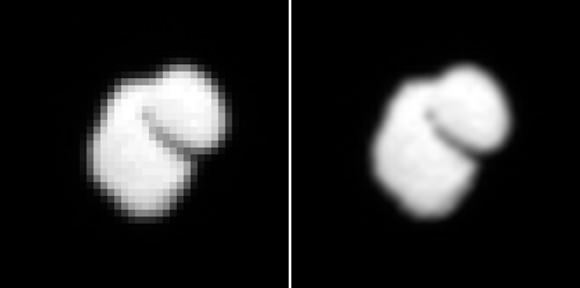
No one knows yet how such an unusual shape formed in the first place. Possibly the comet is a ‘contact binary’ made of two separate comets or two parts of larger, shattered comet that stuck together during a low-velocity collision. This may have happened more 4 billion years ago when the icy building blocks of the planets and comets were numerous and collisions far more frequent than they are today. Contact binaries aren’t uncommon; we see them in asteroids and comets alike.
The Rosetta blog lists other intriguing scenarios:
* The comet may have once been a more spherical object but after many trips around the sun developed an asymmetrical shape from ice vaporization and outgassing.
* A near-catastrophic impact blasted away a huge chunk of comet ice.
* The strong gravitational pull experienced during a close pass of a large planet like Jupiter or Saturn may have pulled it into an irregular shape.
* A large outburst could have weakened a region on the comet’s surface that later crumbled away.
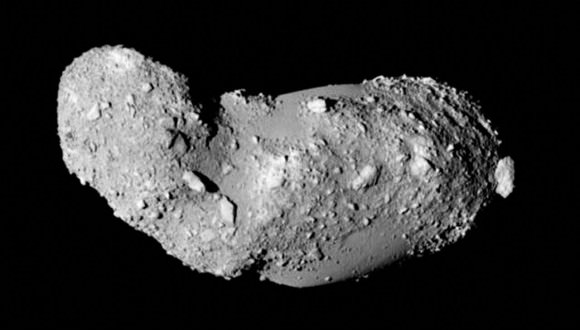
“We will need to perform detailed analyses and modelling of the shape of the comet to determine how best we can fly around such a uniquely shaped body, taking into account flight control and astrodynamics, the science requirements of the mission, and the landing-related elements like landing site analysis and lander-to-orbiter visibility,” said Rosetta Mission Manager Fred Jansen. ” But with fewer than 10,000 km to go before the August 6th rendezvous, our open questions will soon be answered.”
In the meantime, keep the photos and movies coming. We can’t get enough.
Awesome Radar Images Reveal Asteroid 2014 HQ124’s Split Personality
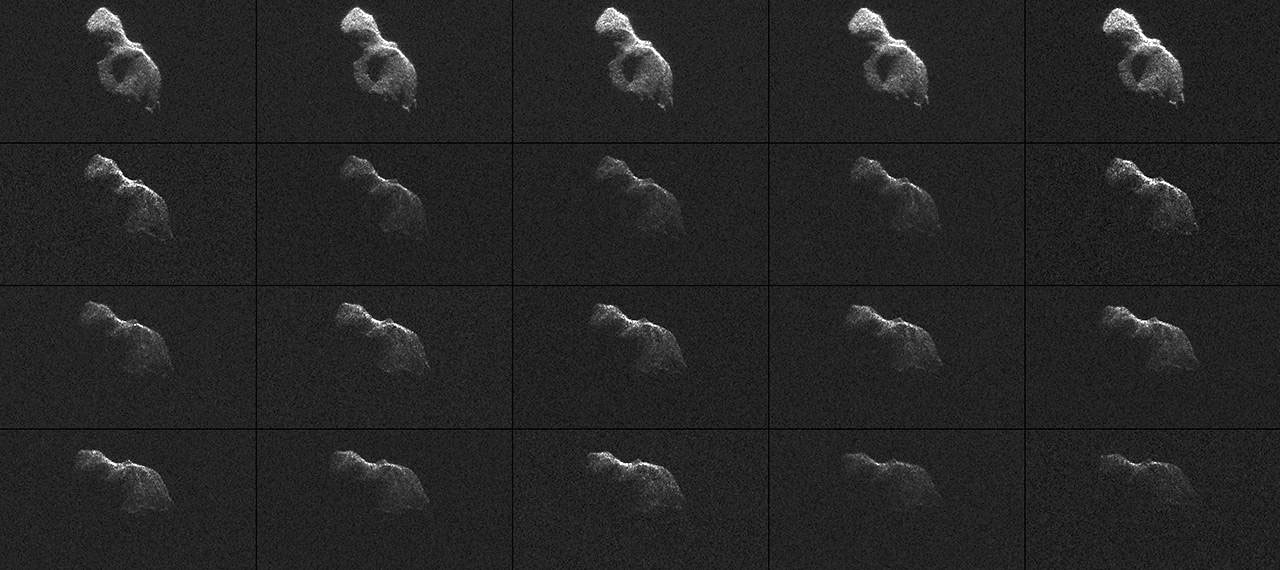
On June 8, the 370-meter (about 1,300-ft.) asteroid 2014 HQ124 breezed by Earth at a distance of just 800,000 miles (1.3 million km). Only hours after closest approach, astronomers used a pair of radio telescopes to produce some of the most detailed images of a near-Earth asteroid ever obtained. They reveal a peanut-shaped world called a ‘contact binary’, an asteroid comprised of two smaller bodies touching.
About one in six asteroids in the near-Earth population has this type of elongated or “peanut” shape. It’s thought that contact binaries form when two or more asteroids get close enough to touch and ‘stick’ together through their mutual gravitational attraction. Asteroid 25143 Itokawa, visited and sampled by the Japanese spacecraft Hayabusa in 2005, is another member of this shapely group.
Radar observations of asteroid 2014 HQ124 seen here in video
The 21 radar images were taken over a span of four hours and reveal a rotation rate of about 20 hours. They also show features as small as about 12 feet (3.75 meters) wide. This is the highest resolution currently possible using scientific radar antennas to produce images. Such sharp views were made possible for this asteroid by linking together two giant radio telescopes to enhance their capabilities.
Astronomers used the 230-foot (70-meter) Deep Space Network antenna at Goldstone, Calif. to beam radar signals at the asteroid which reflected them back to the much larger 1000-foot (305-meter) Arecibo dish in Puerto Rico. The technique greatly increases the amount of detail visible in radar images.
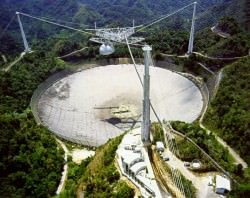
Arecibo Observatory and Goldstone radar facilities are unique for their ability to resolve features on asteroids, while most optical telescopes on the ground would see these cosmic neighbors simply as unresolved points of light. The radar images reveal a host of interesting features, including a large depression on the larger lobe as well as two blocky, sharp-edged features at the bottom on the radar echo (crater wall?) and a small protrusion along its long side that looks like a mountain. Scientists suspect that some of the bright features visible in multiple frames could be surface boulders.
“These radar observations show that the asteroid is a beauty, not a beast”, said Alessondra Springmann, a data analyst at Arecibo Observatory.
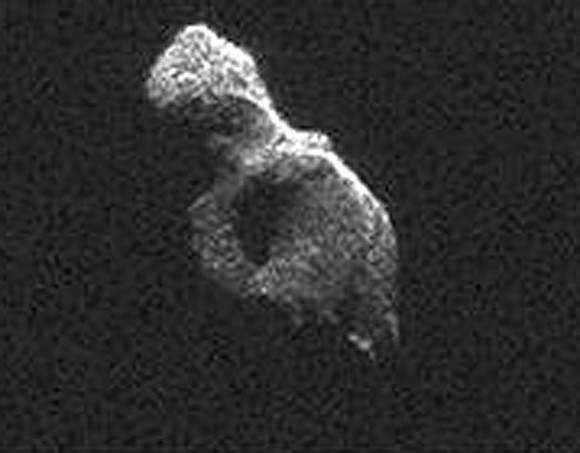
The first five images in the sequence (top row in the montage) represent the data collected by Arecibo, and demonstrate that these data are 30 times brighter than what Goldstone can produce observing on its own. There’s a gap of about 35 minutes between the first and second rows in the montage, representing the time needed to switch from receiving at Arecibo to receiving at the smaller Goldstone station.
If you relish up-close images of asteroids as much as I do, check out NASA’s Asteroid Radar Research site for more photos and information on how radar pictures are made.

